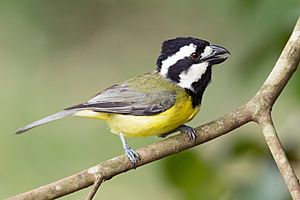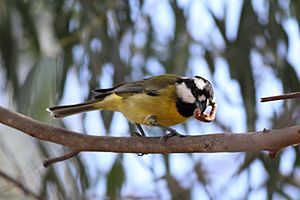Crested shriketit facts for kids
Quick facts for kids Crested shriketit |
|
|---|---|
 |
|
| Male | |
 |
|
| Female | |
| Conservation status | |
| Scientific classification | |
| Subspecies | |
|
See text |
|
| Synonyms | |
|
The crested shriketit (Falcunculus frontatus), or Australian shriketit, is a bird endemic to Australia where it inhabits open eucalypt forest and woodland. It is the only species contained within both the family Falcunculidae and the genus Falcunculus.
Taxonomy and distribution
The crested shriketit was first described by the English ornithologist John Latham in 1801 under the binomial name Lanius frontatus. Nuclear gene sequencing suggests that the crested shriketit required its own family, Falcunculidae (Dickinson 2003).
Subspecies
Three subspecies are recognized, with disjunct ranges and sometimes considered full species:
- Northern shriketit (F. f. whitei), or White's shrike-tit - Campbell, AJ, 1910: Originally described as a separate species. Rare, with isolated records in the Kimberley region of north-western Australia and the Top End of the Northern Territory
- Western shriketit (F. f. leucogaster), or white-bellied shrike-tit - Gould, 1838: sparsely distributed in south-western Western Australia
- Eastern shriketit (F. f. frontatus) - (Latham, 1801): the stronghold of the species; is in south-eastern Australia from the Lower South-East of South Australia, coastally and in the Murray-Darling Basin to south-eastern Queensland, with some scattered occurrences further north and west in Queensland
Description
Males are larger than females in wing length, weight, and bill-size. Males have black throats, while females have olive green.
Behaviour
It feeds mainly on insects, spiders and, sometimes, particularly during the breeding season, young birds. Thistles are also taken. It has a parrot-like bill, used for distinctive bark-stripping behaviour, which gains it access to invertebrates.
Status and conservation
The eastern shriketit is evaluated as being of least concern on the IUCN Red List of Threatened Species, the northern shriketit is considered endangered, and the western shriketit is listed as near threatened. Both the northern and western crested shriketits suffer from habitat loss and fragmentation.
- Dickinson, E. C. 2003. The Howard & Moore Complete Checklist of the Birds of the World. 3rd Ed. Princeton University Press, Princeton, N.J.
- Schodde, R. and I. J. Mason. 1999. Directory of Australian Birds. Passerines: i-x, 1-851. CSIRO Publishing, Canberra.



